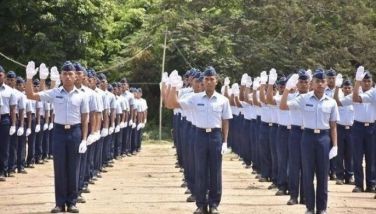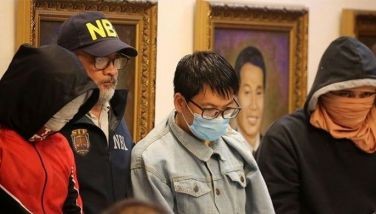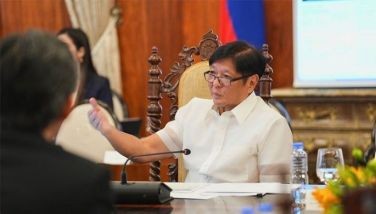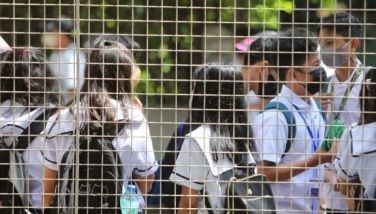Cory to Ninoy: We are not alone
Manila, Philippines - (Former President Corazon Aquino wrote this article on Aug. 21, 2003, Ninoy’s 20th death anniversary. It was written exclusively for a commemorative issue on Ninoy published by PeopleAsia in 2003. It is her own brief account of the years between the time Ninoy was arrested to the day he died and was buried.)
By Corazon Aquino
In pain and sorrow
I have never been alone
Many thanks, dear Lord.
I wrote this haiku in 1982, when Ninoy and I with our five children, Ballsy, Pinky, Noynoy, Viel and Kris were living in exile in Boston, Massachusetts.
I was thinking of the very difficult times under the Marcos dictatorship, when Ninoy was imprisoned for seven years and seven months. From the very first hours of Ninoy’s arrest on Sept. 23, 1972, my children and I experienced whole-hearted support from my parents, sisters and brothers as well as Ninoy’s mother, sisters and brothers. On the advice of my brother, Peping Cojuangco, my children and I left our home at around 2:30 a.m. and transferred to my parents’ home in Makati. On our way to Makati, we passed by Gerry Roxas’ house where he briefed me about his visit to Ninoy in Camp Crame. When we arrived in my parents’ house, my sister Terry and her husband Ricardo (Baby) Lopa were already there. Peping was there and so were Ninoy’s sister, Tessie and her husband, Len Oreta. I did not wake up my parents as I felt the bad news could wait until daybreak, even as I recounted to my relatives what Gerry Roxas had told me.
Tessie accompanied me to Camp Crame at around six o’clock that morning to try and see Ninoy. However, we were only allowed to wave to him from a distance and leave some food for him. It was in the afternoon when my sister-in-law Lupita was able to get permission for me to visit Ninoy. And later that day, it was another sister-in-law, Maur Aquino Lichauco, who reported to me that she followed Ninoy who was transported in a military vehicle from Camp Crame to Fort Bonifacio.
And I shall always remember the time when Ninoy went on a 40 day fast to voice his protest against the trial of civilians by a military tribunal. Ninoy’s hunger strike took place from April 4, 1975 to May 13, 1975. Ninoy was subsisting solely on water, salt tablets, potassium tablets, sugar capsules and amino acid capsules. Friends and relatives organized daily masses for Ninoy. Every evening, around 200 people would pray with us even if they knew their presence was being duly recorded by agents of the Marcos dictatorship. It meant so much to me that my children and I were not alone in praying for Ninoy. And all the prayers really proved effective, as Ninoy ended his hunger strike on May 13, 1975, the feast of our Lady of Fatima. Ninoy had lost 40 pounds, but he was still alive and he would recover in time.
And then there was the unforgettable noise barrage. In a chain letter, the opposition asked the people to join in concerted action on April 6, 1978 or one day before the interim Batasang Pambansa election. The people were asked to start the noise barrage at exactly 9:00 p.m. “making noise with anything, with your palanggana, with your car horns, your voices (about Ninoy), with your pans, something against roofs and walls, etc. Anything that will create noise. If each house in Metro Manila will do this for five continuous minutes, the sound will echo in the city. And Ninoy will know he is not alone. Your ballots will not be counted, but your noise will be heard.” But even before 9 o’clock, all of us at home were making noise, honking the car horns, banging on pots and pans on our street and turning the volume of our radios to the maximum. In no time at all, buses and cars were making a detour from Quezon Avenue and passing Times Street to honk their horns in front of our house. The noise was just unbelievable and when we checked with friends and relatives living in different parts of Metro Manila, they had the same report – it seemed like New Year’s eve and everybody was having fun joining the noise barrage. This was the first time ever that we had some indication of the increasing numbers of Metro Manilans who were voicing their opposition to the dictator and my children and I felt good about this development.
And then 20 years ago, on August 21, 1983, Ninoy returned home hoping to get a chance to talk to Marcos and to try to convince him to restore democracy in our country. But Ninoy was assassinated at the airport, minutes after his plane had landed. From the time my children and I arrived in Manila from Boston on August 24, 1983 we were just amazed at the huge numbers of people who came to pay their last respects to Ninoy in our house on Times Street, in the Santo Domingo Church in Quezon City, in the San Sebastian Cathedral in Tarlac and then back to Santo Domingo Church.
From Tarlac to Quezon City, we took the longer route, the MacArthur Highway instead of the North Diversion Road. There were more towns we would pass through to give more people a chance to see NinoyÅfs hearse. The main streets of these towns were jammed with people and sometimes we could hardly move. It took us nine hours to reach Santo Domingo Church from the Tarlac cathedral.
And finally on August 31, 1983, it was estimated that around two million people went out to see the funeral procession which started at around 10 a.m. from Santo Domingo Church and ended at 9 p.m. in the Manila Memorial Park. The pain of losing Ninoy was lessened somewhat by the magnificent presence of millions of Filipinos. Truly, Our Father in heaven had made sure that my children and I would not be alone in our grief. Talagang hindi kami nag-iisa.
- Latest
- Trending






























